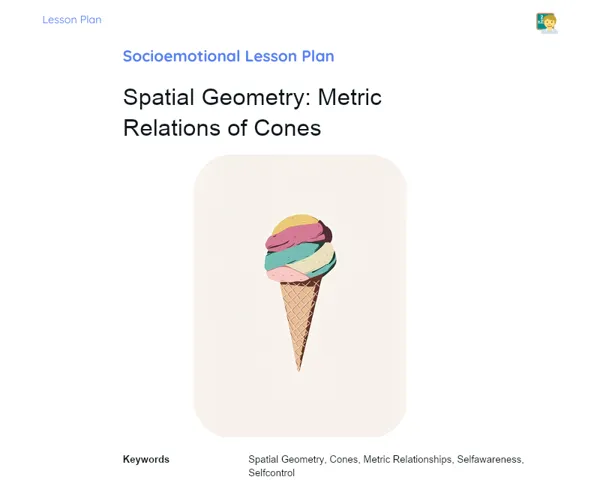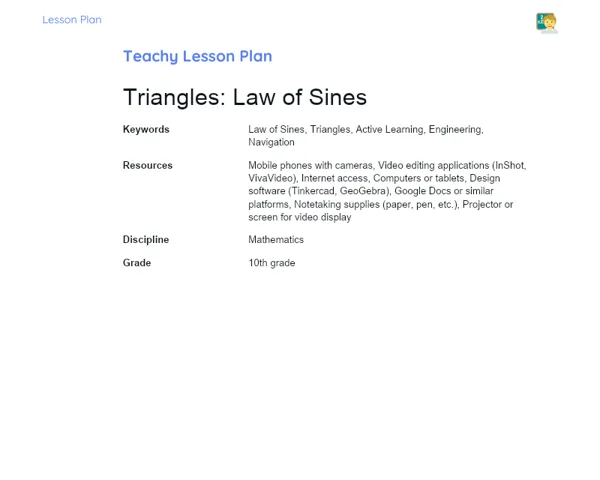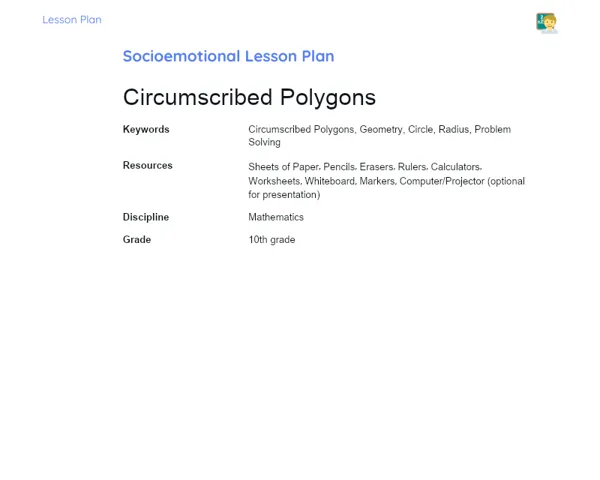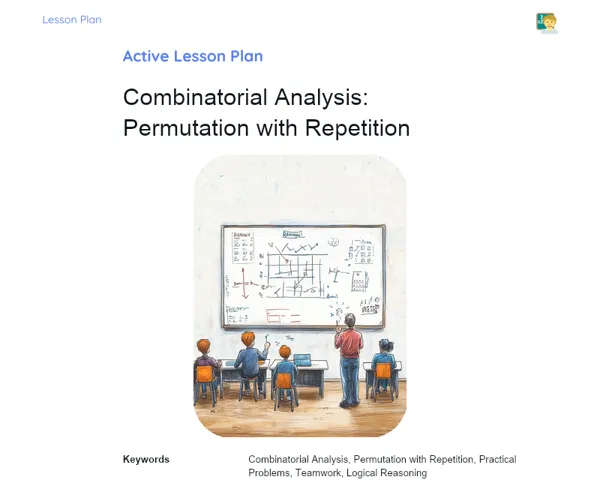Lesson Plan | Socioemotional Learning | Function: Representations and Applications
| Keywords | Mathematical Functions, Dependency Relationships, Graphical Representation, Function Notation, Practical Applications, Self-awareness, Self-regulation, Responsible Decision Making, Social Skills, Social Awareness, RULER Method, Guided Meditation, Emotional Reflection, Emotional Regulation, Personal and Academic Goals |
| Resources | Whiteboard and Markers, Sheets of Paper, Pencils and Erasers, Ruler, Calculators, Computers or Tablets (optional for research), Graphing Material (like grid paper), Notecards for jotting down notes |
| Codes | - |
| Grade | 9th grade |
| Discipline | Mathematics |
Objective
Duration: 10 - 15 minutes
This stage aims to introduce students to the concept of mathematical functions, underlining the significance of how variables depend on each other. This foundational knowledge will prepare them for deeper understanding, allowing students to engage thoughtfully and emotionally in the learning process, acknowledging the relevance of this topic for their day-to-day life and future academic pursuits.
Objective Utama
1. Grasp the idea of function and how two variables are interconnected.
2. Recognize that each input value (x) corresponds to exactly one output value (y) in a function.
3. Identify and represent functions using algebraic expressions and graphs.
Introduction
Duration: 20 - 25 minutes
Emotional Warmup Activity
Finding Inner Peace
Guided Meditation
1. Setup the Environment: Request the students to sit comfortably in their chairs, keeping their backs upright and feet flat on the ground. Encourage them to close their eyes to limit visual distractions.
2. Start with Breathing: Direct the students to take a deep breath through their nose, hold it for a few moments, and gently exhale through their mouth. Repeat this thrice to help ease any initial stress.
3. Focus on Breathing: Ask the students to concentrate on their natural breath, observing how the air flows in and out of their lungs. Encourage them to feel the gentle movement of their bodies with each inhalation and exhalation.
4. Guided Visualization: Lead the students to visualize a serene and safe space, perhaps a peaceful beach or a blooming garden. Describe the scene vividly, engaging their senses: the sound of crashing waves, the fragrance of flowers, and the caress of a calm breeze.
5. Body Awareness: Prompt the students to tune into different sections of their bodies, starting from their feet and gradually moving up to their heads, noting any tension and consciously letting it go.
6. Gradual Return: Instruct the students to slowly shift their awareness back to the classroom by wiggling their fingers and toes. Ask them to gently open their eyes and stretch before diving back into the lesson.
Content Contextualization
Understanding mathematical functions is crucial for more than just math classes; it has applications in everyday contexts, such as grasping how a car’s speed affects travel time or how energy usage relates to electricity bills. By understanding these dependencies, students become better equipped to make informed choices in their lives. Additionally, identifying patterns enhances their analytical skills vital for problem-solving across different domains.
For instance, consider a student planning to save up for a new gadget. Understanding the relationship between their weekly savings (x) and total savings (y) empowers them to manage their finances wisely. Recognizing and applying functions serves as an invaluable skill for practical life and helps develop a logical and organized thought process.
Development
Duration: 60 - 75 minutes
Theory Guide
Duration: 20 - 25 minutes
1. Definition of Function: Clarify that a function is a rule connecting each element of a set of inputs (domain) to precisely one output from a set of outputs (codomain). Use the analogy of a machine that transforms ingredients into a specific dish, where each ingredient (x) yields a specific result (y).
2. Function Notation: Introduce notation like f(x) to indicate a function dependent on the variable x. Make it clear that y=f(x) signifies that y is what you obtain when you apply function f to the value of x.
3. Simple Example: Demonstrate the function f(x) = 2x + 3 to show how each input (x) yields a specific output (y). Use sample values like x=1, x=2, and x=5, and calculate the resulting y values.
4. Graphical Representation: Explain how functions can be visualized graphically. Illustrate that in the equation y=2x+3, each point (x, y) is situated on a Cartesian plane where y is contingent upon x. Sketch the graph on the board for better clarity.
5. Types of Functions: Briefly describe other common function types, such as quadratic and exponential, illustrating the range of relationships modelled by functions.
6. Practical Applications: Share examples of functions in real life, like calculating a car's distance based on its speed and travel time, or estimating population growth over time.
Activity with Socioemotional Feedback
Duration: 35 - 40 minutes
Exploring Functions in Daily Life
Students will collaborate in groups to discover and illustrate functions in everyday scenarios. They will create tables and graphs to exemplify the dependency relationship between variables and share their insights with the class.
1. Group Division: Split the class into groups of 4 to 5 students.
2. Identification of Situations: Each group should select a relatable situation where one variable influences another, such as the correlation between hours studied and exam results, or water intake and hydration levels.
3. Creating Tables and Graphs: Each group will develop a table with values for their chosen variables and subsequently draft the corresponding graph.
4. Presentation: Groups will present their tables and graphs to the class, explaining the variables chosen and the dependency relationships they observed.
5. Discussion and Feedback: Post-presentation, students should reflect on their emotions during the activity, how they articulated their thoughts, and how they managed their feelings while collaborating.
Discussion and Group Feedback
Utilize the RULER method during group discussion by prompting students to recognize their emotions while working together and presenting. Ask if they experienced feelings like anxiety or confidence and to articulate the reasons behind those feelings. Then, guide them to understand the triggers of those emotions—Was it the group dynamic, the pressure of presenting, or some other aspect?
Encourage them to accurately name their emotions, discussing terms like 'nervousness', 'enthusiasm', or 'frustration'. Promote the expression of these emotions in a constructive manner, encouraging open and respectful sharing. Finally, brainstorm strategies to regulate these emotions in future settings, such as employing deep breathing techniques, preparing ahead of time, or seeking help when necessary.
Conclusion
Duration: 15 - 20 minutes
Reflection and Emotional Regulation
For the Reflection and Emotional Regulation segment, invite students to write a brief paragraph or engage in a group discussion about the challenges they encountered during the lesson and how they handled their emotions. Encourage them to reflect on particular moments of strong emotions, like the frustration of not grasping a concept or the satisfaction of solving a problem, and how they dealt with those feelings. This reflection can be conducted in the final 10 minutes of class, allowing students to share their takeaways and learn from one another.
Objective: The goal of this section is to encourage introspection and emotional management by helping students discover effective methods to cope with challenging scenarios. Through contemplation of their emotional experiences, students can enhance their self-awareness and learn to better manage their emotions in academic and personal contexts.
Glimpse into the Future
For the Closure and Looking Ahead, prompt students to establish personal and academic targets related to the lesson material. Ask them to jot down a specific goal aimed at enhancing their understanding of mathematical functions and a personal goal to integrate their learning into their daily lives. For instance, an academic goal could be 'to practice function exercises more regularly', while a personal goal might be 'to apply functions for budgeting my savings.'
Penetapan Objective:
1. Practice function exercises on a weekly basis.
2. Utilize the concept of functions for personal financial planning.
3. Assist a peer in grasping mathematical functions.
4. Explore more on the application of functions across various fields. Objective: The aim of this section is to empower students with autonomy and foster practical applications of their learning. By articulating clear, attainable goals, students can continue nurturing their mathematical and emotional proficiencies, encouraging growth in both their academic and personal journeys. This practice also motivates them to take ownership of their own learning and advancement.



